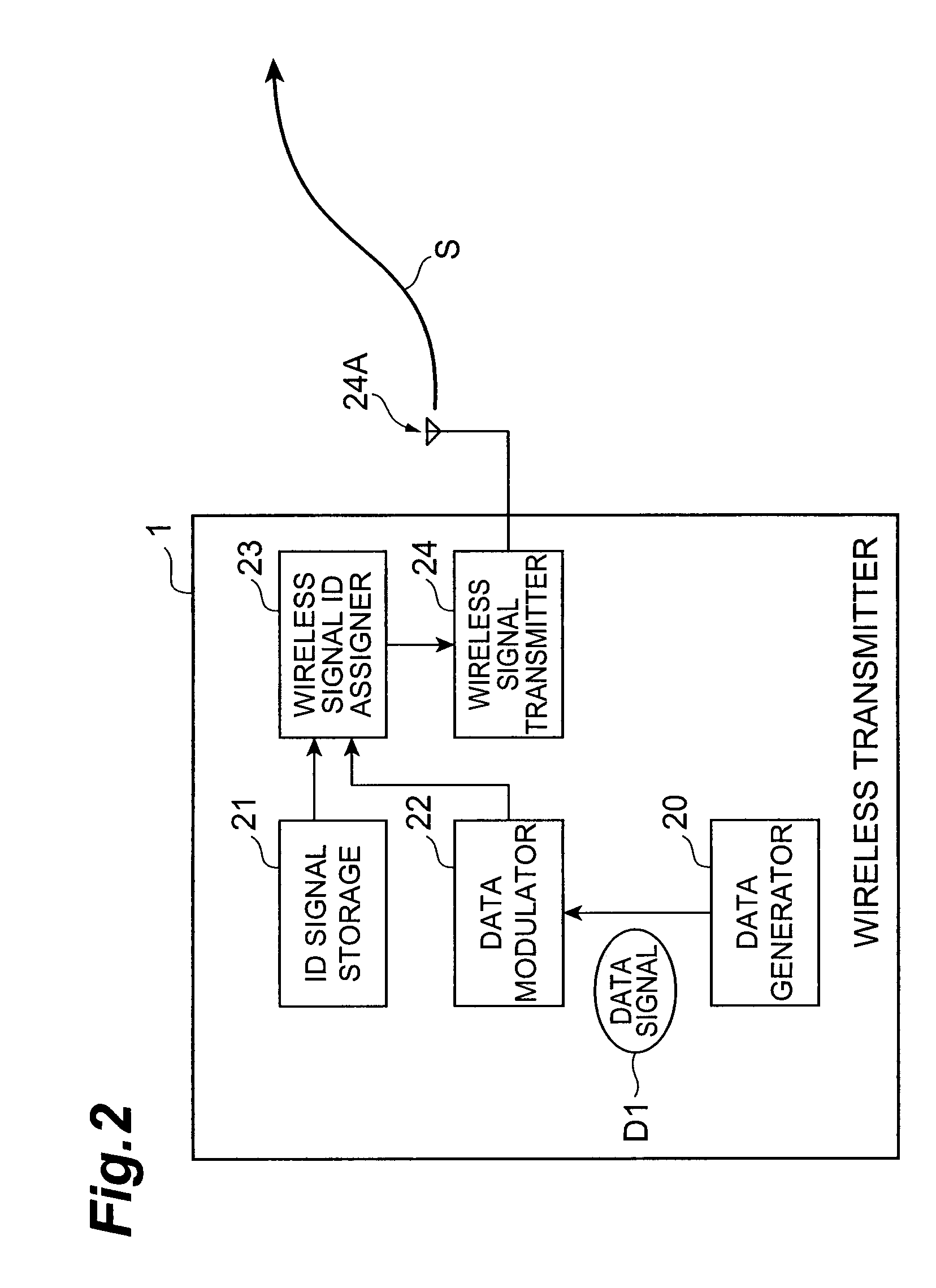[0013]Therefore, the present invention was conceived in view of solving the above problems and an object of the present invention is to provide a
wireless transmitter, a wireless
receiver, a wireless communication
system, and a
wireless signal control method that makes it possible to discriminate the group to which the signal belongs without performing complex
data demodulation processing with respect to a received signal, in an environment where a plurality of groups coexist.
[0021]In addition, in the wireless
transmitter, the ID signal storage module is desirably constituted to determine a frequency and
delay time difference on the basis of an
error correcting code by matching a sequence that is obtained using the
error correcting code with a frequency and
delay time difference by which the power peak for the second or higher-order statistic properties is obtained, and to store an ID signal so that the second or higher-order statistic properties determined by matching an emergence pattern of the power peak of the second or higher-order statistic properties with the
error correcting code are made to appear in the signal to be transmitted; and the wireless signal ID assignment module is desirably constituted to generate the signal to be transmitted on the basis of an ID signal that is stored in the ID signal storage module. In this case, even when an error happens in the
peak detection of the frequency autocorrelation value under the condition that the
noise is large, the group to which the received signal belongs can be discriminated highly accurately by correcting the error.
[0022]In order to achieve the above object, a wireless receiver according to the present invention comprises a second or higher-order statistic properties
database that stores, for each group, second or higher-order statistic properties unique to each of all groups to which a signal to be received possibly belongs; wireless signal reception module that wirelessly receives an incoming signal; and wireless signal group discrimination module that determines the second or higher-order statistic properties pertaining to the signal received by the wireless signal reception module and discriminates the group to which the received signal belongs, by comparing the second or higher-order statistic properties thus determined with second or higher-order statistic properties for each group stored in the second or higher-order statistic properties
database. As a result of this constitution, the IDs can be discriminated simply by observing the second or higher-order statistic quantity added by the wireless
transmitter without performing
data demodulation. Further, by using the second or higher-order statistic properties, the group to which the received signal belongs can be determined highly accurately as a result of the suppression of the
noise component.
[0023]In order to achieve the above object, a wireless communication system according to the present invention is a wireless communication system that is constituted comprising a wireless transmitter and a wireless receiver that exists in the vicinity of the wireless transmitter, wherein the wireless transmitter comprises ID signal storage module for storing an ID signal that identifies a group to which a
data signal to be transmitted belongs and provides, for each group, second or higher-order statistic properties unique to each group; modulator for modulating the data signal; wireless signal ID assignment module for associating the modulated signal modulated by the modulator with the ID signal that is stored in the ID signal storage module, and for generating a signal to be transmitted, by assigning second or higher-order statistic properties that correspond with the ID signal to the modulated signal that is associated with the ID signal; and wireless signal transmission module for wirelessly transmitting the signal that is generated by the wireless signal ID assignment module, and wherein the wireless receiver comprises: a second or higher-order statistic properties
database that stores, for each group, second or higher-order statistic properties unique to each of all groups to which a signal to be received possibly belongs; wireless signal reception module that wirelessly receives an incoming signal; and wireless signal group discrimination module that determines the second or higher-order statistic properties pertaining to the signal received by the wireless signal reception module and, discriminates the group to which the received signal belongs, by comparing the second or higher-order statistic properties thus determined with second or higher-order statistic properties for each group stored in the second or higher-order statistic properties database. As a result of this constitution, in the wireless transmitter, an ID can be assigned to a group to which the signal belongs by using only the second or higher-order statistic properties of the signal to be transmitted and the ID can be identified without performing
data demodulation on the wireless receiver. In addition, by using the second or higher-order statistic properties, the group to which the received signal belongs can be accurately determined as a result of the suppression of the
noise component.
[0028]According to the present invention, in an environment where a plurality of groups coexist, the group to which the signal belongs can be discriminated without performing complex data
demodulation processing on a received signal.
 Login to View More
Login to View More  Login to View More
Login to View More 


